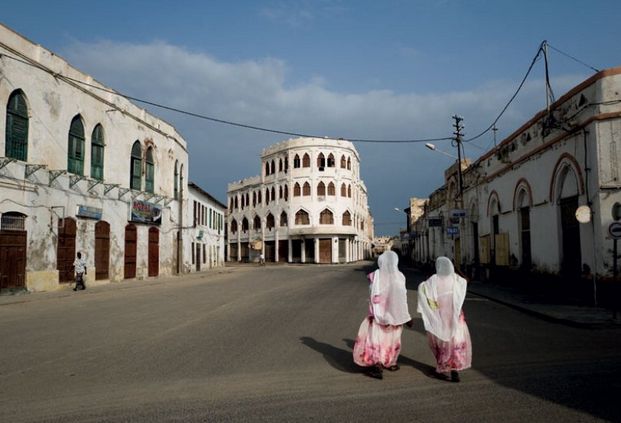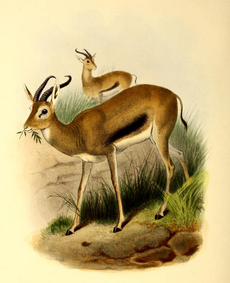Surprising Asmara

Surprising Asmara
75 years after the end of Italian colonization, and 20 years from independence from Ethiopia, the Eritrean capital still has the places and atmospheres of a“little Rome”.
In a Country still full of contradictions.
By Sandro Orlando Photos by Clara Vannucci (D La Repubblica)

Credit Clara Vannucci, a view of Massawa
On Sunday morning the household heads gather in the Pasticceria Moderna, along the old Viale Mussolini, now Harnet Avenue, to have a macchiato coffee and to buy cream puffs. The patisserie gets full after the Holy Mass, as the Catholic Cathedral, one of the most beautiful Lombard Romanesque style churches outside Italy, with its brick walls, is a stone’s throw away.
Next to it there is a cinema with an evocative name, the Impero Cinema, with its unique round windows and its name in very large letters: its 1,800 seat-theatre, decorated with lions and palm trees in Art Déco style, gets full already in the early afternoon.
But before every show, an aperitif at the bar overlooking the boulevard is routine. By that time the
ritual of the stroll has already started: and even in front of the Capitol Cinema, with its dynamic
shape, and the Cinema Roma, a block with a marble façade and large golden letters above it, groups
of young lads gather wearing caftans or untucked shirts.
Car drivers, on the other hand, meet with their white 500 cars at the Fiat Tagliero Station, an extravagant futurist building shaped like an airplane, which has become the city’s symbol. And from here they go to the Bar Aquila or to the Casa degli Italiani, a place with faded and crumbling interiors, for a game of pool, a chat and glass of the local beer, the Melotti.
We are not on the scene of a Federico Fellini movie, but in Asmara: capital of Eritrea, in the
Horn of Africa, an Italian colony for over half a century.
A young nation, which only recently became independent in 1993 after a thirty-year war with Ethiopia, which then changed into a low tension conflict. And also a small nation, with its 4 million inhabitants, divided into nine ethnic groups and four religions (Muslims and Orthodox, Catholics and Protestants.)
A nation besieged by a great power (Ethiopians are in fact 94 millions) and subject to a continuous
demographic hemorrhage: each month, based on UN estimates, 5 thousand Eritreans leave the Country to try and reach Europe on boats crossing the Mediterranean.
Last year 47 thousand Eritreans applied for asylum. And yet Asmara seems anything but a hell to flee from. «It is the only African city with a sewage and water network, the roads are swept daily. Sure, electricity and water are often cut off for a few hours, but overall, life is not bad and you do not see major social disparities», says Giovanni Fasanella, from the office for culture of our Embassy. «People here are honest, there is no corruption, ministers go around without body guards and you do not see flaunted luxury around», he adds.
And so, paradoxically, in spite of reports by the UN and by many organisations for the defense of human rights, which have denounced for years the repressive regime established by dictator Isaias Afewerki (the controlling father of a country, in which elections have never been held and a oneparty system is allowed, there is no freedom of information and an independent judiciary system), the Eritrean capital has the reassuring look of old times Italy. With its atmospheres, its styles and even its habits: because in “little Rome”, as the city was once called during the Fascist period, you eat lasagne and ossobuco (sliced veal shank) for lunch, you stop at Bar Vittoria to play Italian card games and you come across shops with Italian names, like the “Ferramenta” and the “Casa del Formaggio”, while in the streets many rickety Fiat cars are still circulating.
After all, stresses Ms. Perinne Louart, French representative of the Red Cross International Committee in Asmara, you cannot understand where data on arbitrary detentions, tortures, disappearances and other crimes come from, which the UN Commission of Enquiry listed in its last report on Eritrea in June. Since 2009 even the Red Cross no longer has access to Eritrean prisons.
The report, in substance, is based exclusively on former detainees and refugees’ accounts. Who have every interest in describing the situation more catastrophically than it really is. “It is a vicious circle” comments an elderly man, born in Asmara from a Tuscan father, who did not want to be named “young people want to go away to avoid military service, which has an indefinite duration: even ten years, during which they are forced to work hard in the fields, for a ridiculous pay. And the more the rest of the world believes that Eritrea is a ruthless dictatorship, the more their chances to find asylum elsewhere increase”.
It is true that human rights violations, above all against the Oromo minority, are the rule also in nearby Ethiopia. But they do not cause scandal, nor do they ensure a safe-conduit for Europe.
Fear, however, is tangible in Asmara; no Eritrean speaks willingly with a stranger, for fear there may be some spies around. Italian descendants are more open, instead. «Many young people are just looking for an economic improvement, they are encouraged by their families to copy those who went abroad and earn money. So, in order to justify their escape, they blow out of proportion stories heard from other people» says Nadia Biasiolo, an entrepreneur of Italian origin (her family has been living in Asmara for three generations), who has an artisanal weaving workshop with twelve employees. All women, and paid three times more than state employees, she points out. That is: 180 euros a month. «Until 2002 there were perspectives and enthusiasm and many foreigners arrived full of projects» she continues, «but after the war in 2000 we have slowly suffered the disadvantage of an economy under siege, penalised by the lack of water and electricity, and by a diffused feeling of doubt for the future».
After trespassing Eritrean territory, Ethiopian troups have continued to militarily occupy the Badme area, in spite of international condemnations. And this tension, along the 900 kilometres of border, has led to the mobilisation of all Eritreans of military service age, both men and women, between 18 and 40 years. «And yet», continues the entrepreneur, who studied in Rome, «I feel much safer here than in Italy, I can go out in the evening on my own without fears. True, there is an authoritarian government, but this has so far ensured a balance among the various ethnic groups and religions in the Country. It has avoided the danger of Muslim radicalization».
Nadia is the daughter of film producer Giulio Biasiolo, to whom we owe films such as “Le Mille e una notte” of Pier Paolo Pasolini, she has a family history intertwined with the origins of our colonial adventure. Her great grandfather, of Armenian origins, arrived almost at the same time as the first regiment of Bersaglieri, which occupied the port of Massawa in the second half of the nineteenth century to introduce tobacco farming in the Horn of Africa. In 1889 Italians reached the tableau (at 2400 metres height), which dominates the Red Sea, paving the way for the subsequent urbanization of Asmara. It was the beginning of a domination which lasted until 1941.
Four town plans, between 1902 and 1916, gave its first shape to the city, but it was only after
Italy conquered Ethiopia and the Empire was proclaimed in 1935 that Asmara experienced modern development. Under the supervision of Marcello Piacentini, the most famous architectural theorist
of Italy’s Fascist period, and of Vittorio Cafiero, author of the town plan of 1939, crowds of architects indulged in drawing a “city of utopia”, freely inspiring themselves to all the styles of the time, from Eclecticism to Modernism, to the Novecento and Art Déco, from Rationalism to Futurism and Monumentalism.
So, within a few years, on an area of just under five square kilometres, over 4300 buildings of artistic interest were built, with the experimentation of materials and colours, to witness the best of Italianness and its civilizing work.
Sixty years afterwards, the centre of Asmara is still how the Allies found it after the Italians were expelled. «The war against Ethiopia has frozen every development, after that the Regime came, forbidding any new construction. So the town has remained intact», tells Susanna Bortolotto, Restoration lecturer at the Polytechnic of Milan, who also co-operates with the town planning Office of Asmara for a conservation project of its historic centre.
Her co-ordinator, Medhanie Teklemariam, has just presented the city’s candidacy as UNESCO World Heritage Site. «Asmara is an open air museum of modern architecture and town planning», concludes Ms. Bortolotto. «And if the candidacy is accepted, tourists will also arrive». The rediscovery of this artistic heritage may therefore give a future to the Eritrean nation. As a sort of late compensation, after 50 years of colonial occupation.
The former province of the empire.
With the proclamation of the Fascist Empire, in 1935, about 300 thousands service men and 50 thousands civilians emigrated from our peninsula to Eritrea. In 1939, according to a population census of the time, there were 53 thousands Italians living in Asmara, against a total of 98 thousands inhabitants. After British occupation in 1941, approximately 30 thousands of these decided to stay, but after the subsequent annexation of Eritrea to Ethiopia in 1947, their number was halved. In 1975, in the most dramatic moment of the independence war, the Italian government established an air lift to repatriate all Italians living in Asmara. Today, there are still about 800 Italians, but many are the Asmarinos linked to that common past.
For instance, the most famous tailor in town, Mr. Giovanni Mazzola – a great cyclist, who
participated in the Rome Olipmpic Games in 1960, when the marathon runner Abebe Bikila won –
is the (non-recognised) son of an Italian. Traces of this colonial history are visible everywhere, even
in some of the city’s sights, which evoke the atmospheres of Giorgio de Chirico.
After all, from the Albergo Italia (dating back to 1899) to the Orthodox Church, the Synagogue, to
the large Mosque and Catholic Cathedral, going on to ministries, villas, cinemas, bars, stations, markets, the Italians have built everything here.
«And it is not only architectural works, but also open spaces, with boulevards, fountains, stairs, flower boxes », observes Susanna Bortolotto, lecturer at the Polytechnic of Milan, which is already
involved in the excavations of Adulis, the ancient Pompei on the Red Sea, with the objective to teach Eritreans how to restore and enhance this heritage. Waiting for Unesco.




Lascia un commento